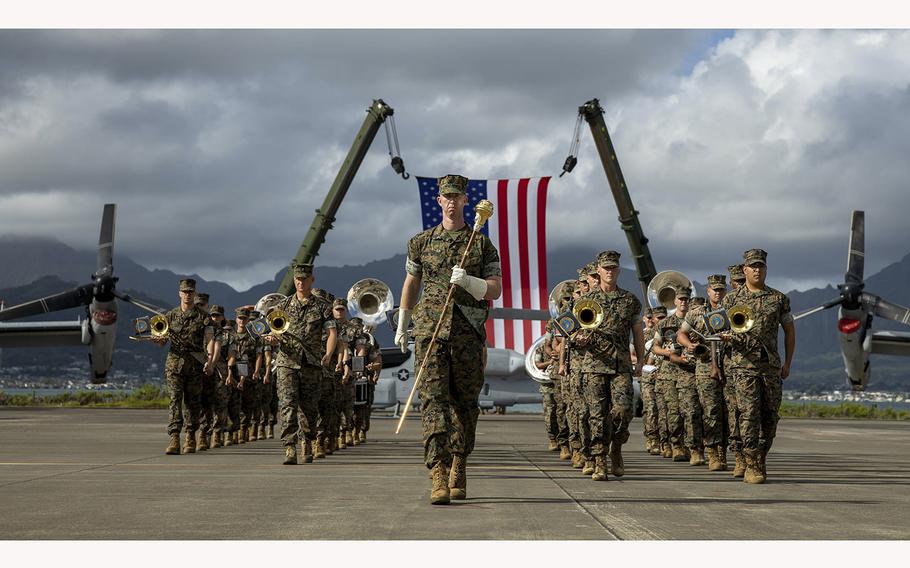
Members of the Marines Corps Forces, Pacific band participate in the MARFORPAC change of command ceremony on Marine Corps Air Station Kaneohe Bay, Marine Corps Base Hawaii, on Wednesday, Sept. 7, 2022, as Lt. Gen. Steven R. Rudder relinquished command to Lt. Gen. William M. Jurney. (Haley Fourmetgustavsen/U.S. Marine Corps)
(Tribune News Service) — Lt. Gen. Steven Rudder handed the reins of Marine Corps Forces, Pacific to Lt. Gen. William Jurney in a Wednesday morning ceremony at Marine Corps Base Hawaii at Kaneohe Bay.
Lt. Gen. Steven Rudder handed the reins of Marine Corps Forces, Pacific to Lt. Gen. William Jurney in a Wednesday morning ceremony at Marine Corps Base Hawaii at Kaneohe Bay.
Rudder, a Marine aviation officer, took command of Marines in the Pacific in July 2020 as the COVID-19 pandemic raged and when it was unclear how soon vaccines would be available. He was also tasked with tackling an ambitious restructuring of Marine Corps forces to conform to the vision of Marine Corps commandant Gen. David Berger, who gave remarks during the ceremony.
"(Rudder ) created over a couple of years an environment where Marines are willing to innovate, are willing to try something different, " Berger said.
Under Force Design 2030, the Marine Corps is making radical changes after two decades of bloody counterinsurgency warfare in Iraqi deserts and Afghan mountains. The service is currently looking to return to its roots as a naval fighting force with a focus on coastal and island warfare with a 21st century twist.
Berger, who formerly led Marine Corps Forces Pacific and has been the most prominent advocate of this push, envisions a future where Marines set up shop on far-flung islands with anti -ship missiles and drones to wreak havoc on enemy naval forces. As part of the reorganization, the service is divesting from tanks and howitzer artillery.
Under Rudder's tenure the Marine Corps activated its first Marine Littoral Regiment, the 3rd MLR, in a ceremony at MCBH in March. The unit is set to be the first of many Marine formations that will specialize in these operations. The unit made its first deployment overseas in May and played a central role in this year's iteration of the biennial Rim of the Pacific exercise.
But the changes have not come without controversy.
Several retired Marine generals have criticized Berger for making changes too radically and accused him of investing in unproven strategies and technology. More recently, a proposal to tear down historic hangars at MCBH to build new ones to support new drone and air tanker squadrons has elicited a backlash from World War II historians and history enthusiasts.
For much of his tenure Rudder was forced to manage relations with allied militaries remotely across the U.S. military's largest theater of operations. But with the much more widespread availability of vaccines and lifting of COVID-19 restrictions around the globe, he has been making up for lost time in face-to-face meetings throughout the region.
This year's iteration of RIMPAC included intensive amphibious fighting. During RIMPAC 2020 there were no amphibious landings as a result of COVID-19 concerns. But this year included the largest amphibious portion in the recurring exercise's history. South Korean navy Rear Adm. Sangmin An led the amphibious task force in an effort that commanders hoped would highlight regional alliances.
"Right around the corner from where we sit, nine nations came ashore, " said Rudder, referencing a multinational amphibious landing at Pyramid Rock at the end of the exercise. "That is becoming not unique. That is becoming the norm in this theater, " he added.
Jurney, an infantry officer who began his Marine Corps career as an enlisted rifleman, takes on operations in the Pacific after a year leading the II Marine Expeditionary Force at Camp Lejune, N.C., where he was focused on Europe and what Force Design 2030 would mean for forces operating there.
Though the reorganization of the Marine Corps is largely geared toward operations in the Pacific, which the Pentagon considers its top priority theater, the Marines have trained extensively in Norway and looked toward the potential of conflict in the Arctic.
"I may be new to the team here, but I can say I'm no stranger to the business of operations in ( U.S. Indo-Pacific Command ), " said Jurney, who has served previous tours in the Pacific.
Jurney takes command at a time when tensions are high in the region. Last month Chinese officials broke off all military and climate talks with the U.S. in response to House Speaker Nancy Pelosi's visit to self-governing Taiwan, which China views as a separatist region.
(c)2022 The Honolulu Star-Advertiser
Visit The Honolulu Star-Advertiser at www.staradvertiser.com
Distributed by Tribune Content Agency, LLC.